

Inauguration
‘Our Work Is But Begun’
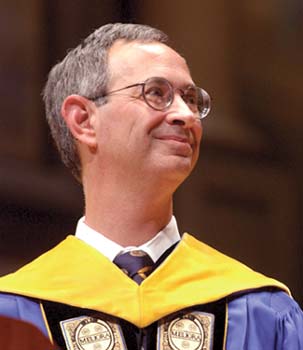 |
More than 150 years ago, Martin Brewer Anderson closed his inaugural address with a phrase that strikes a chord with Rochester’s newest president.
Grounding his own vision of Rochester’s future in an understanding of the University’s achievements and growth over the past century-and-a-half, Joel Seligman paid homage to his predecessors in urging the University community to look forward.
“Our ambition is to aim high,” Seligman said as he was formally installed as Rochester’s 10th president. “Working together, we will demonstrate that Martin Brewer Anderson’s words are as true today as they were in 1854: ‘Our work is but begun!’”
Seligman’s address capped a three-day weekend of events to mark his inauguration as Rochester’s top executive on October 23. Coinciding with the College’s annual Meliora Weekend, the festivities drew on time-honored traditions and served as a chance for the University to celebrate its future.
What follows are highlights—including Seligman’s full inaugural
message—of the celebration. Visit the Inauguration
page for more coverage, including photos, video, and transcripts. A fully
annotated copy of Seligman’s inaugural address is also available.
We Are One University
‘We have the opportunity to recharacterize ourselves, to stretch the frontiers of our research, improve the quality of our teaching and scholarship, and develop the type of pathbreaking programs that have long distinguished the University of Rochester.’ By Joel Seligman
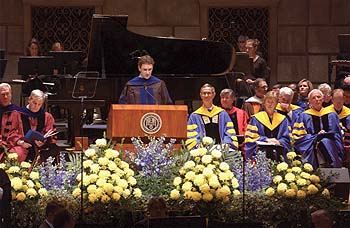 |
| WELCOME: Nicholas Bigelow, the Lee A. DuBridge Professor of Physics, welcomes Seligman on behalf of the faculty. |
I am proud to accept the opportunity to serve as the 10th president of the University of Rochester. This is a University of which all of us can be proud, with an inspiring history; outstanding faculty, students, alumni, and staff; extraordinary teaching, scholarship, clinical, and performance programs; and a long tradition of distinguished academic leadership, most recently personified by our three living former presidents—Robert Sproull, Dennis O’Brien, and Thomas Jackson.
I am honored to speak today in the presence of representatives from leading universities and colleges of our nation and around the world. We are particularly privileged to be joined by the speakers and moderator from this morning’s Inaugural Symposium: Lee Bollinger, president of Columbia University; Amy Gutmann, president of the University of Pennsylvania; Dr. William Peck, former executive vice chancellor for medical affairs at Washington University; John Sexton, president of New York University; and Hugo Sonnenschein, former president of the University of Chicago.
And I am especially proud today to be accompanied by my wife, Friederike, my best friend, my most thoughtful advisor. For 24 years we have lived a fairy-tale life, in part because of our two wonderful children, Andrea and Peter. We are honored to join the University of Rochester family.
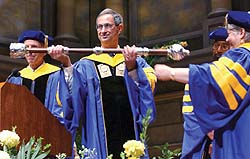 |
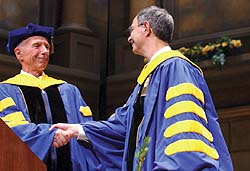 |
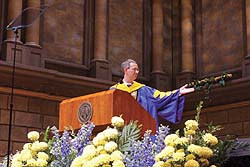 |
| INVESTITURE: Seligman accepts the mace, a symbol of presidential authority (top), from Elissa Newport, the George Eastman Professor of Brain and Cognitive Sciences, and University Marshal Jesse Moore, professor emeritus of history; G. Robert Witmer Jr. ’59, chairman of the Board of Trustees, congratulates the new president (middle), and Seligman acknowledges his wife, Friederike, during his address. |
Nine times before in the 155-year history of the University of Rochester a president has delivered an inaugural address. An inaugural address is an opportunity to articulate the values that animate the University at a given time and that frame its aspirations. For me, these values are best appreciated historically.
Martin Brewer Anderson, our first president, celebrated “The Ends and Means of a Liberal Education” in his 1854 inaugural address, implicitly agreeing with Cardinal Newman’s assertion that “[k]nowledge is capable of being its own end” and firmly rejecting vocational learning as “that which strictly belongs to the trade.” Anderson was a man of fervent principle who opposed an elective curriculum, dormitories for students, and university athletics. For Anderson, “spiritual interests transcend[ed] all others.”
In its first 50 years under the leadership of Anderson and David J. Hill, Rochester succeeded as a University in name, but a college in fact. The University was small, with an enrollment of 216 students in 1897; sectarian, long with an express requirement that the president be a Baptist; but accommodating to the fundamental reorientation then occurring in American higher education.
Harvard University’s Charles Eliot popularized the elective system for undergraduates after he began as president in 1869. By 1891, the University of Rochester was steering a course between “the Scylla of conservatism and the Charybdis of reform.” In his last report as president, David Hill proudly informed the trustees that the University “offered all but two [of the] courses that President Eliot . . . reported as those most frequently chosen by undergraduates [at Harvard].” Significantly, as early as his inaugural address, Hill emphasized “the growth of science [as necessitating] a great revolution in pedagogical methods. . . . Museums, laboratories, and apparatus are now indispensable to respectable collegiate instruction. . . . It is now impossible to teach the natural sciences, even in their elements, by the use of text-books alone.”
These reforms were bounded. Among the most significant American educational innovations in the late 19th century was the founding of Johns Hopkins in 1876 as a graduate school that focused on research. Harvard soon emphasized graduate professional schools. In the late 19th century, the University of Rochester lacked the means to join these and other leading universities in the early development of graduate education.
Then an almost miraculous series of events occurred. During the 35-year presidency of Rush Rhees, a small regional college was transformed into an authentic national university. Rhees provided the academic leadership for this transformation. But more than anyone else, George Eastman is responsible for today’s University of Rochester. To be precise, the University of Rochester is the school that George Eastman built.
In the first decades of the 20th century, new facilities for science and engineering were opened, largely funded by Eastman and Andrew Carnegie. These buildings made possible our first engineering degrees in 1913, and an approximate doubling of the University’s enrollment to 433 students in that same year.
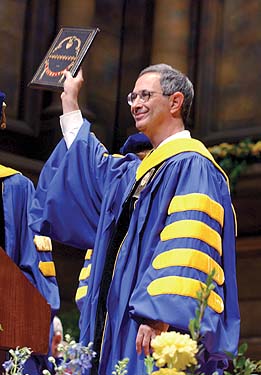 |
| CHARTERED: Seligman holds the University’s charter, presented to him during the ceremony. |
After World War I, Eastman’s munificence increased. In 1918, Eastman posed to Rush Rhees the type of question every university president yearns to hear: “Why don’t you have a music school?” Within months, Eastman committed himself to providing Rochester with two magnificent concert halls and a school of music “surpassed by no other in the world.” Rarely has an aspiration been so completely realized. From the opening of the University of Rochester’s Eastman School of Music in 1921, the basis was provided for what is widely regarded today as one of the finest music programs offered anywhere in the world.
Nearly simultaneously, Eastman provided decisive support for the founding of the University of Rochester’s School of Medicine and Dentistry. In 1919, Eastman endowed what was then known as the Dental Dispensary and now, the Eastman Dental Center. The following year, after the personal advocacy of Abraham Flexner, Eastman committed himself to a pledge of $4 million that initially funded approximately one half of the School of Medicine and Dentistry. Flexner, who then served as secretary to the Rockefeller General Education Board, persuaded John D. Rockefeller Jr. to fund $5 million, with the Strong family providing the final $1 million. Eastman added another $2.5 million in 1923, wryly observing: “If I had known his baby was going to grow so fast I should probably have told Flexner to take it back at the beginning, but it was such a pretty baby that one does not want to give it up without a struggle to help support it.”
These gifts placed the University of Rochester in the vanguard of a revolution in medical education. The School of Medicine and Dentistry followed the model of Dr. William H. Welch of Johns Hopkins Medical School and Flexner’s celebrated 1910 report, “Medical Education in the United States and Canada.” The school required an undergraduate degree to ensure that students were grounded in chemistry, biology, and physics. The medical school was linked both to a university and a teaching hospital and emphasized “learning by doing” with a full-time faculty that included a vigorous commitment to research led by our initial dean and future Nobel laureate George Whipple.
Eastman also enabled us to relocate much of our University to the River Campus, which now aptly includes the beautiful Rush Rhees Library. Among other consequences of the more capacious campus was a dramatic expansion of graduate education. In 1925, the University of Rochester awarded its first Ph.D. degree. Today approximately 46 percent of our 8,500 students are graduate students.
Eastman’s final gift to the University of Rochester may have been the largest single bequest made to an American university through the time of his death in 1932. The $51 million total of his bequest and other gifts provided the nucleus of the University of Rochester’s endowment, which long after World War II was among the five largest in the country.
The complexity of our University accelerated after World War II. Four new schools emerged from existing departments by 1971. The Warner Graduate School of Education and Human Development provides a distinctive emphasis on interdisciplinary research; the School of Engineering includes the first optics program in the country and recently added a biomedical engineering program; the Simon Graduate School of Business Administration set an international standard with Jensen and Meckling’s pathbreaking work on agency costs; and the School of Nursing has achieved national prominence for consolidating nursing clinical care, education, and research within its Unification Model.
World
Premiere
‘To Seek and to Find’
If a presidential search were set to music, what would it sound like?
The answer from composer Robert Morris, professor of composition at the Eastman
School, came alive in an 18-minute work that had its world premiere at Seligman’s
inaugural ceremony.
Titled Quaerere et Invenire (the Latin translation for “to seek
and to find”), the composition was performed by pianist Nelita True, professor
of piano, and the Eastman Chamber Winds under the direction of Mark Davis Scatterday
’89E, chair of the Department of Conducting and Ensembles at the Eastman
School.
The performance is available as part of the Webcast
of the inauguration.
Allen Wallis pledged, “[t]o each his Farthest Star” at his 1963 inaugural, and under Wallis and his successor, Bob Sproull, the University of Rochester fortified its position as a Research One University, buoyed by expansive post–World War II federal funding. Dennis O’Brien particularly addressed the challenge of undergraduates, proclaiming, “Let our signature be liberal education in a professional world,” adding the distinctive Take Five undergraduate year and endorsing both metaphoric and physical bridges to the Rochester community. Tom Jackson’s presidency long will be remembered for the 1995 Renaissance Plan, which, among other topics, articulated our model of decentralized administration; the 1996 Medical Center strategic plan; and the distinctive Rochester Curriculum of the College. Collectively, these plans achieved their purpose to “reassert the University’s greatness.”
But the transformation of a small liberal arts college into a Research One University, replete with six schools, a dental center, a Laser Lab, a celebrated art gallery, a leading academic health center, and several affiliated programs, fundamentally challenges our sense of collective identity. We are no longer “a single community . . . of masters and students,” but a confederacy of separate communities, united by a common name, a common governing board, and a common location. As University of California President Clark Kerr memorably stated in his exploration of “The Idea of a Multiversity”:
“The multiversity is . . . not one community but several—the community of the undergraduate and the community of the graduate; the community of the humanist, the community of the social scientist, the community of the scientist, the communities of the professional schools; . . . the community of the administrators.”
To Kerr, the multiversity best could be characterized “as a series of individual faculty entrepreneurs held together by a common grievance over parking.”
I hold a more sanguine view. We are one University, powerfully bound by values that are responsible for this and other universities being among the most significant social institutions in the world today.
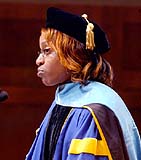 |
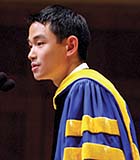 |
| GREETINGS: Kim Dyce Faucette ’89, ’05W (EdD), chief of staff for the Rochester City School District, and Matt Goldblatt ’06, president of the Students’ Association, welcome Seligman. | |
We are first, and unabashedly, committed to the idea of academic excellence. We pride ourselves, regardless of school or department, on hiring the best teachers, scholars, and clinicians and limiting tenure to those who satisfy rigorous standards. Our students are admitted selectively, based on the comparative strength of their qualifications. We are, as former Harvard University president Derek Bok has observed, distinguished by our sense of competition—“for faculty members, for students, for funds. . . .” This commitment to excellence has provided some of the finest scholarship, the finest teaching, the greatest health centers, and the most outstanding science the world has ever known.
We do not compromise the rigor of our standards. But over time the concept of academic excellence itself has evolved. A prescribed curriculum long was considered essential to the building of a “single community of masters and scholars.” Prescription, however, risks stultification and tends to inhibit appreciation of new scholarship and new discovery. Today we practice instead a form of academic pluralism. In the College, for example, each undergraduate student, within the broad limits of our cluster curriculum, becomes master of her or his academic program. We have come to appreciate that students, like faculty, often learn best when they study what they love.
For our faculty, academic excellence also has been redefined. Long before it became fashionable, we encouraged collaboration and interdisciplinary study at the University of Rochester. The Rochester ideal long has championed a well-rounded education for all students, including those in a specific major or graduate degree specialty. After World War II, the University of Rochester medical school initiated its own distinctive biopsychosocial model of medical education, linking science and the humanities. In 1963, our Center for Visual Science linked scholars from optics, psychology, electrical engineering, brain research, and ophthalmology. Mastery of a specific field remains a hallmark of academic achievement. But the finest scholarship and teaching often demand a team approach joining scholars from multiple disciplines to best study a ubiquitous problem.
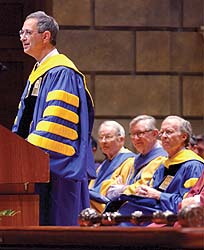 |
| PRESIDENTIAL: Rochester’s three living former presidents—Robert L. Sproull, Dennis O’Brien, and Thomas H. Jackson—listen to the inaugural address. |
Academic freedom is a second fundamental value of our University. Academic freedom, meaning the freedom of our faculty to research, publish, and teach without outside direction or restriction is powerfully fortified by the institution of tenure. Subject to the adequate performance of their duties, our professors enjoy a freedom distinctly greater than that of business, government, or military employees. Academic freedom can be characterized as the ultimate social bet that individual merit is more likely to produce outstanding scholarship and teaching than thought directed by command and control.
Today academic freedom is being fundamentally tested. The enormous growth of federal research funding and federal and state law increasingly comes with ever-ensnaring strings. Society’s interest in topics such as stem cell research has meant there are tensions between the religious beliefs of some and the scientific interests of the University. From time to time faculty members or students will make statements that offend their fellow faculty, students, or the community at large.
My role in these debates is clear. I will defend the academic freedom of this University. The university is one of the longest lasting social institutions in the world precisely because it is a safe haven for thought that is new, daring, or controversial. The conventional wisdom of any period too often appears foolish or prejudiced in retrospect. We are—and should be proud to be—the intellectual laboratory for the ideas that change the world. My job as a steward of this University is to protect the process in which innovation, novel scholarship, and discovery best can flourish.
Diversity is a third fundamental value of this University. Universities have learned that the exclusion of persons based on gender, race, nationality, religion, or sexual orientation, among other formulae, limited their ability to provide the most outstanding teaching, research, and scholarship. Few memories are more cherished in the history of the University of Rochester than that of Susan B. Anthony persuading our Board of Trustees to admit women to the class that entered in 1900. It is a measure of significant progress that today over half of all students enrolled in four-year American colleges and universities were women.
Higher Education and the 21st Century
A commitment to diversity, however, goes beyond an ending of typological exclusions. As the United States Supreme Court majority memorably wrote in Grutter v. Bollinger, a case that validated the legal position of one of our Inaugural Symposium speakers, “Student body diversity is a compelling state interest that can justify the use of race in university admissions” because of such substantial benefits as promotion of crossracial understanding, breaking down of stereotypes, empathy for persons of different races, the likelihood that diverse students “will contribute the most to the ‘robust exchange of ideas’” and, I would add, better preparation of all of our students for the intensely competitive multicultural world in which they will live and work.
Our goal, as Grutter stressed, is a university “that is both exceptionally academically qualified and broadly diverse.” This is a goal not limited to student admissions, but extends to each facet of our University.
Diversity is most effective when concomitant with the principle of mutual respect. We will not always agree with each other, but in an academic institution committed to free and open inquiry, we should defend the right of all to think, to speak, to write, to teach, and to learn, including those with whom we most fervently disagree. We are, to paraphrase Justice Holmes, a marketplace for ideas, not a battlefield.
There is a fourth fundamental value that has been recognized since the first presidential inaugural address. We are committed to the greater Rochester community. We are proud to be an urban University; proud to be the major health care provider in this region; proud that our students, faculty, alumni, and staff are deeply involved in community service; proud of the role we perform as employers, consumers, and neighbors in a community and region we dearly love. We have become the largest employer in our immediate geographic area and the generator of an increasing number of new businesses.
We serve our community best by striving to be the most outstanding university that we can be. That is why universities are magnets for the economic progress that is the key to our increasingly knowledge-based society. We have also substantially contributed to the arts in a community celebrated for music, art, and dance. Our ties to Rochester are inextricable, and these ties will grow.
For our faculty, students, and alumni, Rochester is our home, but the world is our stage. Modern transportation and communications have made ours an ever-shrinking world. Our faculty and students today come from 80 nations; the University has affiliated programs in 35 countries. We are providing scholarship, research, and teaching designed to be of value across the globe. The University of Rochester will increasingly be part of an international community of higher education.
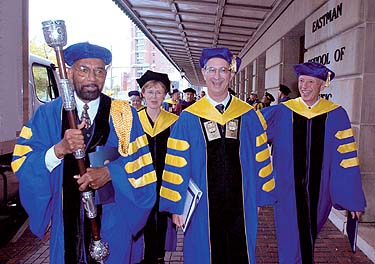 |
| LEADING: Moore, Frederike Seligman, and Witmer accompany Seligman as they leave Eastman Theatre after the ceremony. |
The significance of this evolving higher education community highlights the importance of our commitment to academic excellence, academic freedom, and diversity. For the University of Rochester and the American university generally, these are our comparative advantages. We do not provide the least expensive education, nor the simplest, nor the most comfortable. We pride ourselves in involving our students and faculty in open and rigorous debate, original research and scholarship, and the challenge to work effectively in what will be a world of the intellect largely without borders. During the 21st century, academic knowledge, innovation, and highly trained professionals will be valued as never before.
One hundred fifty-one years ago, Martin Brewer Anderson concluded his inaugural address with the stirring peroration: “Our work is but begun.”
In the years to come, the University of Rochester will embark on the largest capital campaign in its history.
Our fundamental challenge is one of vision. What type of university will we be in the 21st century? We have the opportunity to recharacterize ourselves, to stretch the frontiers of our research, improve the quality of our teaching and scholarship, and develop the type of pathbreaking programs that have long distinguished the University of Rochester. We are blessed at this University with extraordinary talent. With plans that inspire our alumni and friends, I am confident that we will dramatically accelerate our progress.
Our ambition is to aim high. Working together, we will demonstrate that Martin Brewer Anderson’s words are as true today as they were in 1854: “Our work is but begun!”
Higher
Education and the 21st Century
Investing in teaching and research that addresses globalization while at
the same time engaging local communities; appreciating individualism while respecting
‘the other’; speaking ‘truth to power’ while relying
on financial support from a public that may not always want to hear it—these
are just a few of the challenges facing higher education in the 21st century,
according to a panel of experts convened for the inauguration of Joel Seligman.
“Don’t you love higher education, and don’t you wish everybody
did?” Amy Gutmann asked rhetorically after outlining some of the contradictory
pressures that top administrators face in leading the nation’s colleges
and universities.
It was clear that Gutmann, the president of the University of Pennsylvania,
did, as did the audience that nearly filled Strong Auditorium to listen as she
and her fellow panelists outlined some of the challenges for higher education
in a 90-minute session empanelled to mark the inauguration of Joel Seligman
last October.
Moderated by Hugo Sonnenschein ’61, president emeritus of the University
of Chicago and a trustee at Rochester, the panel also included Lee Bollinger,
president of Columbia University; William Peck ’60M (MD), ’00 (HNR),
former executive vice chancellor for medical affairs at Washington University
in St. Louis and a Rochester trustee; and John Sexton, president of New York
University.
In addition to sharing their thoughts on higher education in the 21st century,
the panelists were recognized during the inauguration ceremony. Gutmann, Bollinger,
and Sexton received honorary degrees, and Peck received the Hutchison Medal,
the University’s highest alumni honor.
Here are excerpts from the panel discussion. A slide
show of the session is also available online.
Sonnenschein: We depend on our universities to teach our young,
to give them the tools that will enable them to do better in succeeding generations
than we have in our own. But this does not happen easily or by itself. It requires
that our work be understood well by the larger society. It requires resources—very,
very substantial resources. It requires advocacy and it requires most skillful
leadership. Leaders who can leap tall buildings in a single bound, leaders who
have the political skills of a U.S. senator, the managerial skills of a Fortune
500 CEO, and the academic credentials of a Nobel laureate.
Fortunately, the University of Rochester found such a person and, fortunately,
we have four other such remarkable people with us. I should say, as good as
all these people are, I am not sure we serve ourselves well by expecting so
very much of them.
Bollinger: [I] think not only is (globalization) one of the
great new areas for academic work, but I think we are not sufficiently in the
game. . . . [A]nother problem is that we have developed in many areas, especially
in the social sciences, frameworks for thinking about issues that are more removed
from actual problems, actual phenomena, in the world than has been true in the
past and, while I’m not being critical of that at the moment, it leaves
us at this particular moment in time less able to address actual problems that
are being posed by these phenomenal developments that we call globalization.
. . . I think what it comes to is that we simply do not have enough people,
enough of our minds, really focused on these great problems.
Gutmann: [W]e are at an amazing time in the history of higher
education. . . . [N]ot to put too fine a point on it, we have gone, in my lifetime
and I think most of your lifetimes, from being bastions of privilege and noblesse
oblige run by, and primarily catering to, one class, one race and, yes, one
gender, to far more diverse and dynamic fellowships of scholars and learners
who embrace our neighbors and our local communities around the world as equal
partners to whom we can owe respect and from whom we have a lot to learn. .
. .
And yet part of embracing others brings with it a challenge. We find ourselves
these days under constant attack from all sides. So we must not be Pollyanna-ish
about what it means to be in the public eye and want to be contributing to the
public good. . . . The truth is that for all of this controversy, almost everybody—and
I’m tempted to say every reasonable person—recognizes the value
of higher education. That is, people are beating down our doors to get into
wonderful places like the University of Rochester. And you know what? They are
right to do so. It is a ticket not just to a productive life—although
that’s a very important ticket—but it is also a ticket to lifelong
learning and to the love of learning that all of us in this room share.
So, I want to take heart. And I think all of us presidents need to take heart
that these criticisms are a small price to pay for engaging outside of the ivory
tower and for extending the frontiers of knowledge and discovery.
Peck: [Another] area of needed collaboration is . . . the organization
and financing of health care in this country. . . . The burden of costs is being
borne principally by the employers, major employers in this nation, and they
cannot sustain it. . . . [I]n my view, the most important issue is the fact
that we happen to have 45 million Americans who have no health insurance and
receive inferior health care and very few preventive services and another untold,
unaccounted number of underinsured at any one time. That number is growing because
of the rising costs. . . . [T]he basis for the cures of this tremendous problem
must come from universities. It is not coming from anywhere else. . . . It means
that community physicians, academic physicians, other health professionals,
sociologists, economists, political scientists, philosophers must get together
and formulate solutions that will change American health care, transform American
health care well into the future. This is no easy task. But it must be done
because we all, all of us, are stakeholders in health.
Sexton: It’s important in these times that we question
all authority, but most important is the fact that we understand that this is
a culture that is moving to dogmatism of first-level certainty. . . . What we
(as universities) do is complexity and nuance. If a society that continues to
marginalize complexity and nuance continues to be the hegemonic society, we
lose. And that’s why funding is moving away from us, and we have to call
to account that kind of simple-minded society because it contradicts the kind
of openness that each of the speakers here has spoken about and in which we
currently live.
